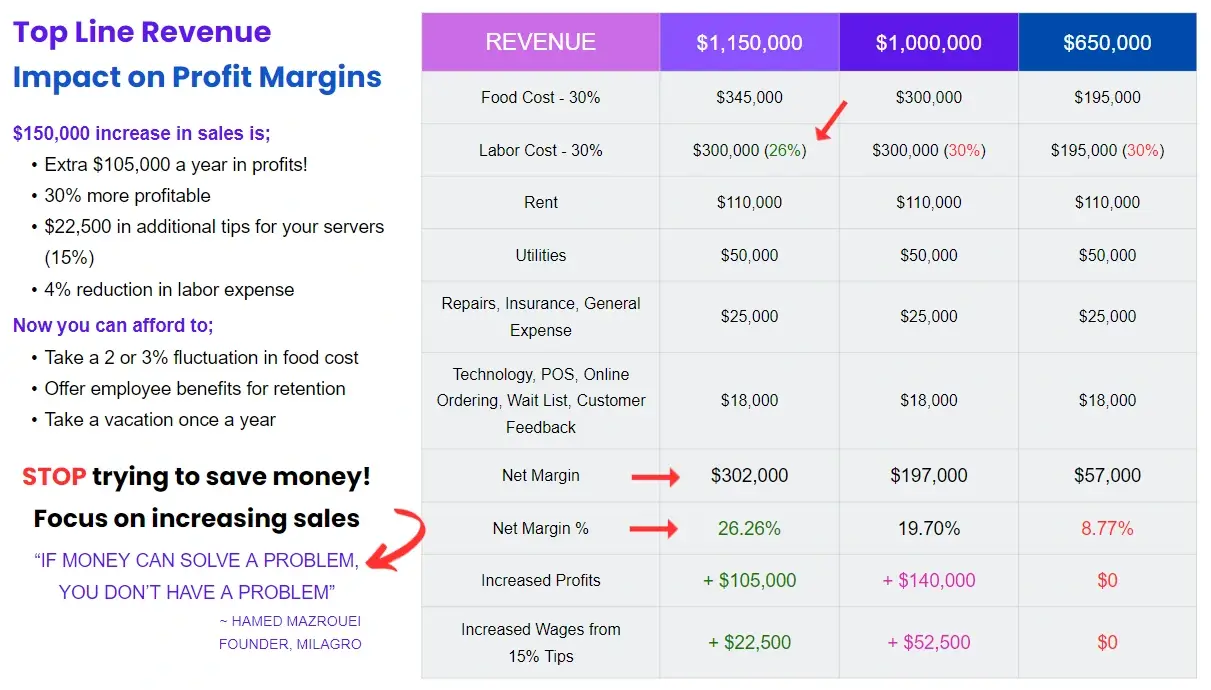In recent times, the restaurant industry has witnessed a surge in additional surcharges being levied on customers, from higher tip rates, now 18 to 25%, to miscellaneous fees such as credit card charges of 4% and staff healthcare contributions or misc. fees of 4 to 5%, to name just a few of them. These extra restaurant fees are generating significant debate and raising concerns about the health of the industry and have made headlines several times, which is going to put the industry under further pressure bringing more attention to the soaring cost of dining out, which will further reduce traffic to restaurants, thereby, adding more pressure to the profitability of restaurants. While these fees may seem like a straightforward solution to the industry’s challenges, it is merely a band-aid, not a cure.
The Financial Crunch
At the heart of this issue lies the financial pressure faced by most restaurants, but certainly not all restaurants. With average annual sales of the restaurant industry as a whole hovering around $750,000, these establishments are often perceived as having razor-thin profit margins. This financial crunch has given rise to a cycle where restaurants justify their surcharges under the banner of preserving profitability. As tip rates increase, credit card fees accumulate, and healthcare costs get passed onto the customer, questions arise about the sustainability and ethics of this approach.
This is a symptom of a more fundamental problem that no one has paid any attention to in the past two decades as businesses have evolved and adopted more efficient ways to increase top-line revenue and manage expenses. The restaurant industry lags in adopting modern technology and specifically marketing technologies to drive top-line revenue, which has created a multi-billion dollar opportunity for other companies to maximize and monetize on this opportunity, take for example, UberEats and DoorDash. The lack of strategic customer outreach, retention strategies, and the failure to adopt proper technology have led to the current state of affairs. As staggering as it may seem, a whopping 70% of customers visit a restaurant just once, a statistic that underscores the urgency for a comprehensive shift in approach. Any business with a top-line revenue of $750,000 a year, will in fact have thin margins because of overhead costs to operate a business, labor will be a challenge because you cannot afford to pay people a reasonable salary and cost of sales/food may seem high at 30%. To add fuel to the fire, nearly every single restaurant owner is focused strictly on cutting everything down by reducing labor costs, reducing food costs, reducing expenses, reducing quality, or anything else you can imagine to cut costs.
“Business does become profitable by reducing expenses. Stop trying to save money and focus on increasing sales!”

Restaurants are very profitable and scalable businesses to own and operate in the hands of the right leadership and tech-savvy individuals. I am personally surrounded by some of the most successful individuals owning restaurants with success beyond my imagination, some averaging over $550,000 a month in top-line revenue, not at once location but across a portfolio of locations in different geographical regions. So that begs the question; why are some wildly successful and some consistently struggling with “thin margins”, labor challenges, and high food costs? These successful restaurant brands, I have yet to hear them complain that they have thin margins, of course, they too, have had to deal with increased food costs but they can absorb the fluctuation and remain very profitable due to high top-line revenue.
The Potential Solution?
The solution to this crisis rests in the development of a dual-pronged business strategy. A solid customer acquisition strategy and a customer retention strategy. All businesses have either a Customer Acquisition or a Customer Retention challenge. For some businesses, it is easier to acquire new customers but difficult to retain them, case in point: in the restaurant industry, restaurants can get new customers but lose 70% of their customers after just one visit. In other businesses, it is very difficult to acquire a customer, but their retention is impeccable, customers are retained for several years, for example, in a tech company – it is difficult to acquire a customer, but once onboarded, retention is generally 3 to 7 years. Customer acquisition is always the most difficult in comparison to customer retention, simply because it is difficult to change the prospect’s behavior, and it is easier to keep an existing customer happy and give them no reason to go elsewhere.
The first facet entails a robust Customer Acquisition strategy, employing innovative techniques like 3rd Party Delivery services (expensive but works), Social Media campaigns (time-consuming but works), even direct mail fliers (inefficient but works), and targeted marketing efforts (difficult but works). Each has its own advantages and disadvantages but that is just business, every entrepreneur signed up for it, nothing is easy, and nothing is free, I am in the same boat dealing with and overcoming the same challenges alongside every other business owner, but this is what we signed up for.
However, the true game-changing opportunity in the restaurant industry lies in the second component – a solid, automated, and personalized Customer Retention Strategy. Astonishingly, less than 1% of restaurants employ such a strategy, leaving a significant void in an essential business aspect. How can a business operate, let alone thrive, on just 30% of its customers? It cannot, hence the rise of tip rates to 25%, the addition of a 4% surcharge for credit card use, and 4 or 5% fees to cover the basic business expenses. The lack of a business owner’s ability to increase top-line revenue is forcing additional surcharges until it becomes unsustainable and goes out of business because it can no longer compete. This emphasizes on the importance of a solid customer retention strategy, a business owner cannot indefinitely be in a hamster wheel of customer acquisition, it is unsustainable.
The financial pressures that lead to fee escalations are symptomatic of a larger issue: many restaurants are managed by well-intentioned individuals with a passion for hospitality but lack the full spectrum of business acumen. It is simply impossible to be an expert in everything. It’s a scenario where efficiency meets its match in the intricate world of culinary artistry. Running and operating a restaurant is more than amazing food and amazing experiences. In a world filled with fierce competition, being proactive and tech-savvy is the foundation of success.
In conclusion, the surge in restaurant fees reflects a broader challenge that necessitates strategic transformation within the industry. The path forward lies in reimagining restaurant operations as both a culinary haven and a well-managed business enterprise. By embracing cutting-edge marketing technologies and prioritizing customer retention, the restaurant industry can break free from the cycle of surcharges and ensure a sustainable future for all stakeholders involved.
It will not be easy, it will require the commitment of time, resources, and technology, but those who embrace it, will prosper and be wildly successful leaving their competitors to scratch their heads trying to figure out what happened.
As always, cheers to your successful journey fellow business owner,
“The future belongs to those who dare to imagine the impossible”
Truly yours
Hamed

Compare the difference between a profitable and unprofitable restaurant business by understanding the impact of top-line revenue on the bottom line. By focusing on increasing sales, get rid of your Thin Margins, and Labor Challenges and stop worrying about Food Cost.
By increasing sales from $1MM a year to $1.15MM a year;
-
- An extra $105,000 in net profit
- $22,500 in additional wages for staff (15% tip of course, not 25%)
- Reduced labor cost by 4%






